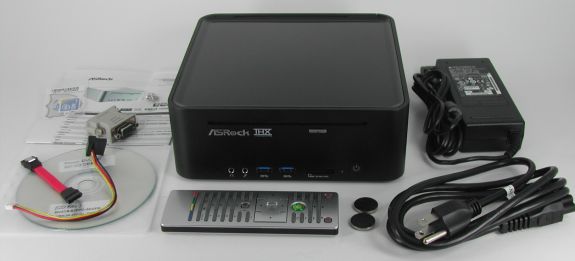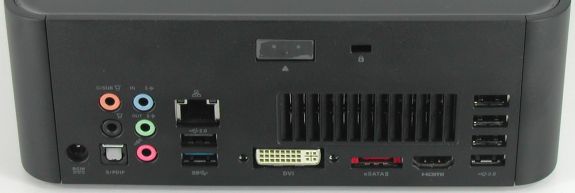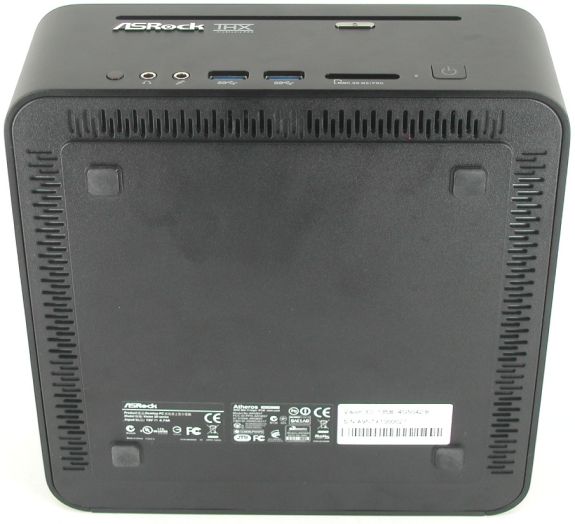ASRock's High-End Vision 3D HTPC Reviewed
by Ganesh T S on October 3, 2010 10:20 AM ESTThe ASRock Vision 3D HTPC package is similar in size to the Core 100 package.
Apart from the main unit, the package also bundles the following:
- 90W AC / DC Adapter
- SATA and power cables, as well as mounting screws for a 2.5" hard disk
- DVI to VGA adapter
- MCE remote and a couple of CR232 batteries.
- Manual with instructions for disassembling and replacing the MXM card
- CDs with drivers and ASRock utilities, as well as PowerDVD 3D BD Player (OEM version)
While the Core 100 and ION 330 shared a similar industrial design, ASRock realized that a high end HTPC needed a shift in appearance. It now brings a Mac Mini look, though the dimensions are still the same as that of the Core 100 and ION 330. The edges are no longer abrupt, and the slimline BD drive has been replaced by a slot loading one. These are exactly the points with which we found issues in the Core 100 review. Of course, people who are concerned with the aesthetics may object to the large number of ports and imprints on the front side of the unit. In a future design, ASRock may probably shift the imprints to the top panel and hide the front ports with a full width hinged door of sorts.
Like the Core 100, the front panel has two audio jacks and two USB ports. In addition, there is also a SD card reader. However, unlike the Core 100, there are no ventilation slots in the front panel. The IR receiver is also visible. Also, the sides of the chassis are not used as antennae for the Wi-Fi (there are two metal plates inside the chassis at the rear end for this purpose).
Moving to the rear of the unit, we have a power adapter input, GbE port, eSATA port and audio jacks similar to the Core 100. However, the VGA port in the Core 100 is replaced by a dual link DVI port in the Vision 3D. The HDMI port is also HDMI 1.4a. There are 5 USB 2.0 ports and 1 USB 3.0 port to wrap up the ports in the rear. Instead of a fan slot, we have air ventilation slots, which are of the type found on the sides of a notebook. There is also a provision for a Kensington lock and a push-button mechanism to lift off the top panel.
An interesting deviation from the Core 100 exterior design is the underside of the unit. While the Core 100 was plain and needed an anti-slip pad for stability, the Vision 3D is raised with rubber bushes, and also has ventilation slots three sides, as can be seen in the picture below.
Just like a notebook, this unit also supports simultaneous display on two monitors. Testing was done mostly with the HDMI output connected to a Toshiba REGZA 37" 1080p TV through an Onkyo TX-SR 606, and the DVI port connected to a old Dell monitor running at 1280x1024. The Vision 3D ships with no OS installed. For the purpose of this review, we loaded up a copy of Windows 7 Ultimate x64. It is also possible to install Ubuntu or any other Linux distribution and still be able to take advantage of most of the HTPC functions of the system. Our analysis in the rest of the article, however, is completely from the Windows 7 standpoint.
We will conclude this section with a table to summarize the data and A/V connectivity options for the Vision 3D HTPC.
| Option | Status |
|---|---|
| HDMI | Yes [v1.4a] |
| Component | No |
| Composite | No |
| VGA | Yes [with DVI-VGA adapter] |
| SPDIF | Yes [Optical] |
| Stereo | Yes |
| Option | Status |
|---|---|
| Optical Disk Drive | Yes [Blu-Ray] |
| USB | Yes [5 x v2.0, 3 x v3.0] |
| eSATA | Yes |
| LAN | Yes [ 1000 Mbps GbE ] |
| Internal HDD | Yes [ 500 GB ] |
| WiFi | Yes [ 300 Mbps 802.11n ] |
| Card Reader | Yes |














51 Comments
View All Comments
ProDigit - Sunday, October 3, 2010 - link
Looks interesting at first, but I don't much like nvidia graphics cards, and the WD drive.WD drives are known to break right after their warranty expires when using them a lot.
The only good about the nvidia card is that it could be set up to work with CUDA (CPU + GPU in parrallel); although cuda now also supports most ATI/AMD cards.
The price of this setup is quite on the high end. If it wasn't for 3D vision, I'd say this computer would go for no more than $699. With 3D, I'd say $799 max.
I personally don't care if it supports 3D or not, since I have no monitors that support this resolution. So for me it's only worth $599.
ProDigit - Sunday, October 3, 2010 - link
They should have gone with a Toshiba drive instead. Yes, WD has faster continuous write and read speeds, but Toshiba is much better in IO performance.An OS like Windows 7 would boot faster with Toshiba, than with WD, and would run significantly cooler too!
WD is absolutely NOT the best drive they could have chosen! The cheapest perhaps yes.
ganeshts - Sunday, October 3, 2010 - link
Looks like the WD Scorpio Black is as good as the Momentus XT from Seagate (except for the Disk Capture benchmark):http://www.storagereview.com/western_digital_scorp...
So, from a price-performance ratio, it makes sense to go with WD.
I have also mentioned in my review that a mini-PCIE SSD for the boot drive would have been good :)
sprockkets - Sunday, October 3, 2010 - link
The best notebook drives were made by IBM, and now Hitachi. Whether that still is the case, who knows.Zok - Sunday, October 3, 2010 - link
CUDA is not supported on ATI/AMD cards. DirectCompute and OpenCL are, however, supported by both.LtGoonRush - Sunday, October 3, 2010 - link
Studies of both operating disk populations and drives sent in for data recovery show that no brand of drives is measurably more or less reliable than others, with the notable exception of the Seagate model ranges affected by their firmware bugs. It's also been conclusively proven that drive usage doesn't affect failure rates; lightly loaded and heavily loaded drives fail at the same rate. It's true that a failing drive will have its death hastened by heavy load, but you shouldn't be using a drive that's failing anyway, it should be replaced with the first SMART error it logs. The WD Scorpio Black drives in particular are the fastest notebook HDDs available, balancing high throughput with excellent seek times (Seagate drives have always had abysmal seek performance). It's also a little silly to complain about heat when we're talking about drives with sub-4W PEAK power draw.chrnochime - Sunday, October 3, 2010 - link
great job for correcting him without making it more obvious how wrong he is. I would've not sugarcoat it as much as you did though heh.lexluthermiester - Sunday, October 3, 2010 - link
Seriously? Not liking Nvidia, well that is just personal preference. You not having a TV/Monitor that supports what this system can put out is not the fault of the maker or the system itself, it your problem. But bashing WD? They make the finest hard drives in the world and there are certainly worse hard drive makers. Now I'm not going to be low class and name names, but really? And if you don't like this little system, then don't buy it, but don't bash something that certainly has usefulness to a certain audience of users and at a very fair price.Parhel - Sunday, October 3, 2010 - link
False. WD drives are not "known" for high failure rates. All drive manufacturers compare about evenly in most areas. WD is one of, if not the, best choice out there.Samus - Sunday, October 3, 2010 - link
I was a WD fan in the 90's and after the 7200.7's came out and they ditch the wetsuits I became a die-hard Seagate fan because of the 7200.7's legendary reliability, low cost, 5-year warranty and 'decent' performance. These were all big selling points during an era where the Deathstar 75GXP rocked the storage industry with what some circles were calling a "definitive" failure rate within the warranty period.The Seagate drives just worked. However, recently I've had a lot of Seagate 7200.10 and 7200.11 drives giving me SMART errors, specifically reallocated sector counts. They also run hot compared to my new WD Blue 1TB drive and they're all mounted in the same cage. A few years ago I had a 1.5TB Seagate I had to flash to CC1G because of the firmware 'recall' which was definitely a quality control concern. I didn't loose data, but I know somebody who did, one day their drive was just blank. We flashed the firmware and his data was back, but the drive failed after a few months without warning, just spun up and clicked. Tried freezing it. No dice.
Seems like WD is taking the quality/reliability crown, where as they've always had the performance crown...but performance wasn't as important to me as making sure the drive would work for 3-5 years without any issues.
I'd consider a Hitachi in the future, but will probably continue to stick with Seagate and WD drives. Considering how many dead Samsung and Fujitsu drives I've pulled and replaced from friends' desktop and laptop's over the years, it's a no-brainier to stay the hell away from those. Toshiba I have mixed feelings about because over the past 20-years, I just didn't care much for their laptops. Hypocritically, I love Thinkpad's but when IBM had those 75GXP failures, I didn't change my mind about their laptops, and still think they make the best laptop's out there. Ironically things are different now, because Hitachi makes the hard drives and Lenovo makes the Thinkpad's. IBM has little to do with either now.